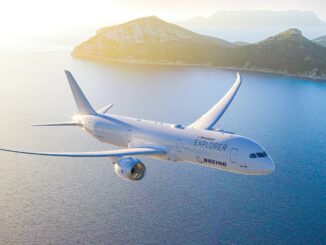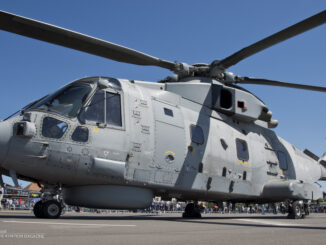 Boeing 737-8Z6 (Boeing Business Jet 737-800, c/n 35478, HS-MVS of His Majesty King Maha Vajiralongkorn), taxiing on apron of Franz Josef Strauss Airport, Munich, October 2018
Boeing 737-8Z6 (Boeing Business Jet 737-800, c/n 35478, HS-MVS of His Majesty King Maha Vajiralongkorn), taxiing on apron of Franz Josef Strauss Airport, Munich, October 2018
On 9th April 1967, prototype of Boeing 737 narrow-body passenger aircraft successfully completed its maiden flight. The aircraft was developed as a supplement to other Boeing airliners offered at that time, aimed for customers that wanted to provide comfort travelling on short haul routes.
The first serial variant of the aircraft, 737-100, was introduced into operational service on 10th February 1968 with Lufthansa. An interesting fact is that this German national airline was the only significant customer for the 737-100, thus – for the first time in history of the company – the new Boeing airliner was launched into commercial operations outside America. Nevertheless, demand for such a small airliner like the 737-100 was very small and only thirty examples of that aircraft were built.
Commercial success for the new airliner came only with its second variant, that featured extended-fuselage and was designated 737-200. The aeroplane entered service in April of 1968 and almost 1,100 examples were built until 1988, when its production was ceased.
In 1979, the Boeing company introduced new generation of the 737 airliner, including its -300, -400 and -500 series. Those aeroplanes were commonly known as ´the Classic´ 737, in contrast to -100 and -200 series that were nicknamed ´the Original´. The second generation was manufactured between 1984 and 2000, with approximately 2,000 aeroplanes built.
The third generation, designated ´Next Generation´, was launched in 1993. It included the 737-600, -700, -800 and -900 series, and was chosen as base for two military aircraft – Boeing C-40 Clipper and Boeing P-8 Poseidon. The third generation was manufactured until 2016, with approximately 7,000 examples built.
The current, fourth generation of the 737 airliner is officially designated 737 MAX and was introduced in 2011. It includes the 737-7, -8, -9 and -10 series, with approximately 4,500 aeroplanes made and delivered until today.
In addition to the third generation, there was also a specialized Boeing Business Jet (BBJ), simultaneously introduced to the market and aimed for VIP customers, such as heads of state, billionaires and highest corporate officers. The BBJs were offered in three variants, based on the -700, -800 and -900 series, respectively.
The Boeing 737 featured today in our Photo of the Week series, was built in 2007, as the BBJ2 based on the 737-800 series. The aeroplane was acquired by the Royal Thai Air Force, nevertheless it was included in civilian aircraft register, as HS-TYS. During its service with the RTAF, that 737 was part of the Royal Flight Unit within the 603rd Transport Squadron of the 6th Wing, officially based at Don Muang air base.
However, the aeroplane was for most of the time based not in Thailand, but at Munich Airport. The reason was the 737 was put at the disposal of Thai crown prince Vajiralongkorn, who lived in Bavaria, Germany.
In December of 2016, the crown prince accepted the throne after death of his father, and officially was coronated in 2019.
In 2017, King Maha Vajiralongkorn transferred the 737-800, as well as some further RTAF aircraft, to his private fleet. According to the Financial Times business newspaper, the private fleet of the Thai king includes thirty-eight aircraft – three Airbus and four Boeing airliners, three Sukhoi Superjets, four F-5E fighters and twenty-one helicopters (following an article issued by Financial Times in early 2021).
At the time of its transfer, the 737-800 changed registration to HS-MVS. However, the aeroplane still carries the markings of the RTAF. Despite taking the throne, King Maha Vajiralongkorn did not change his lifestyle and still spends most of its time in Bavaria. Therefore, his 737-800 is still being based in Munich.
An interesting fact is that King Maha Vajiralongkorn is known from his affection for aviation. Although he spent a few years in the Royal Thai Army, serving in intelligence and security units, King Maha Vajiralongkorn is also a qualified military pilot. According to information appearing from time to time in the press, he is trained and authorized to fly the F-5E and F-16 fighters, as well as the Boeing 737 airliner.



